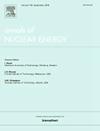Development of a two-phase flow solver with drift-flux model based on OpenFOAM: Validation against single/two-phase and boiling flow
IF 1.9
3区 工程技术
Q1 NUCLEAR SCIENCE & TECHNOLOGY
引用次数: 0
Abstract
Based on the open-source finite volume method platform OpenFOAM, this paper implements a two-phase flow solver for drift partial non-equilibrium models with realistic closure relations. The solver inherits the numerical method from the OpenFOAM framework, adopts the large-time step transient PIMPLE algorithm, and follows its discrete and matrix-solving criteria, focusing on developing a two-phase flow model and constitutive models. The constitutive model is utilized as a library by the drift flux solver, covering the pre-CHF flow patterns in vertical channels. The drift velocity model is based on Ishii and his collaborators’ work. The remaining models, such as wall friction, wall heat transfer, interfacial heat and mass transfer, are taken from TRACE Theory Manual. To fulfill the condition of conjugate heat transfer between fluid and solid, a virtual solid heat transfer function is developed under the premise of a single-domain solver. Extensive and successful validation has been conducted involving single-phase, two-phase, and boiling flow heat transfer phenomena by comparing with experimental data or typical system codes, and the two-phase flow solver’s success has been demonstrated in several aspects. This will support future multi-scale and multi-physics coupling work within the OpenFOAM framework.
求助全文
约1分钟内获得全文
求助全文
来源期刊

Annals of Nuclear Energy
工程技术-核科学技术
CiteScore
4.30
自引率
21.10%
发文量
632
审稿时长
7.3 months
期刊介绍:
Annals of Nuclear Energy provides an international medium for the communication of original research, ideas and developments in all areas of the field of nuclear energy science and technology. Its scope embraces nuclear fuel reserves, fuel cycles and cost, materials, processing, system and component technology (fission only), design and optimization, direct conversion of nuclear energy sources, environmental control, reactor physics, heat transfer and fluid dynamics, structural analysis, fuel management, future developments, nuclear fuel and safety, nuclear aerosol, neutron physics, computer technology (both software and hardware), risk assessment, radioactive waste disposal and reactor thermal hydraulics. Papers submitted to Annals need to demonstrate a clear link to nuclear power generation/nuclear engineering. Papers which deal with pure nuclear physics, pure health physics, imaging, or attenuation and shielding properties of concretes and various geological materials are not within the scope of the journal. Also, papers that deal with policy or economics are not within the scope of the journal.
 求助内容:
求助内容: 应助结果提醒方式:
应助结果提醒方式:


